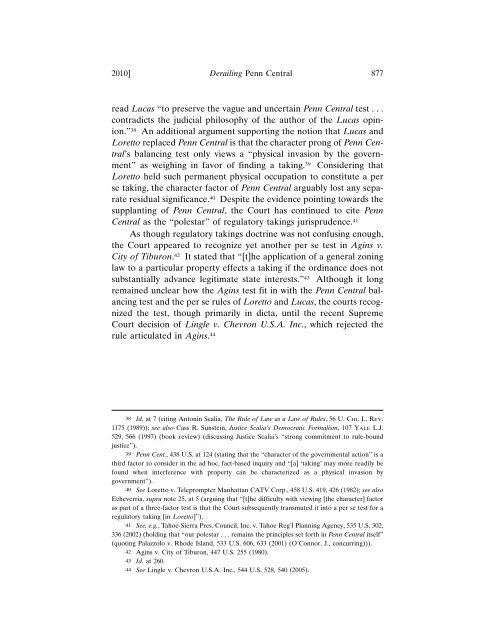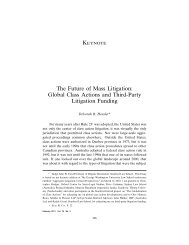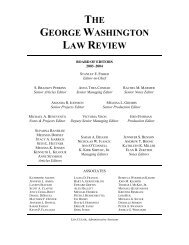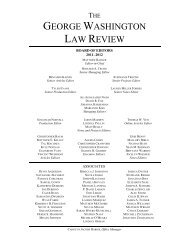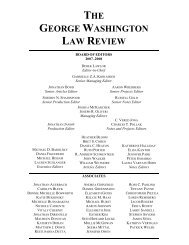View PDF - The George Washington Law Review
View PDF - The George Washington Law Review
View PDF - The George Washington Law Review
You also want an ePaper? Increase the reach of your titles
YUMPU automatically turns print PDFs into web optimized ePapers that Google loves.
2010] Derailing Penn Central 877<br />
read Lucas “to preserve the vague and uncertain Penn Central test . . .<br />
contradicts the judicial philosophy of the author of the Lucas opinion.”<br />
38 An additional argument supporting the notion that Lucas and<br />
Loretto replaced Penn Central is that the character prong of Penn Central’s<br />
balancing test only views a “physical invasion by the government”<br />
as weighing in favor of finding a taking. 39 Considering that<br />
Loretto held such permanent physical occupation to constitute a per<br />
se taking, the character factor of Penn Central arguably lost any separate<br />
residual significance. 40 Despite the evidence pointing towards the<br />
supplanting of Penn Central, the Court has continued to cite Penn<br />
Central as the “polestar” of regulatory takings jurisprudence. 41<br />
As though regulatory takings doctrine was not confusing enough,<br />
the Court appeared to recognize yet another per se test in Agins v.<br />
City of Tiburon. 42 It stated that “[t]he application of a general zoning<br />
law to a particular property effects a taking if the ordinance does not<br />
substantially advance legitimate state interests.” 43 Although it long<br />
remained unclear how the Agins test fit in with the Penn Central balancing<br />
test and the per se rules of Loretto and Lucas, the courts recognized<br />
the test, though primarily in dicta, until the recent Supreme<br />
Court decision of Lingle v. Chevron U.S.A. Inc., which rejected the<br />
rule articulated in Agins. 44<br />
38 Id. at 7 (citing Antonin Scalia, <strong>The</strong> Rule of <strong>Law</strong> as a <strong>Law</strong> of Rules, 56 U. CHI. L. REV.<br />
1175 (1989)); see also Cass R. Sunstein, Justice Scalia’s Democratic Formalism, 107 YALE L.J.<br />
529, 566 (1997) (book review) (discussing Justice Scalia’s “strong commitment to rule-bound<br />
justice”).<br />
39 Penn Cent., 438 U.S. at 124 (stating that the “character of the governmental action” is a<br />
third factor to consider in the ad hoc, fact-based inquiry and “[a] ‘taking’ may more readily be<br />
found when interference with property can be characterized as a physical invasion by<br />
government”).<br />
40 See Loretto v. Teleprompter Manhattan CATV Corp., 458 U.S. 419, 426 (1982); see also<br />
Echeverria, supra note 25, at 5 (arguing that “[t]he difficulty with viewing [the character] factor<br />
as part of a three-factor test is that the Court subsequently transmuted it into a per se test for a<br />
regulatory taking [in Loretto]”).<br />
41 See, e.g., Tahoe-Sierra Pres. Council, Inc. v. Tahoe Reg’l Planning Agency, 535 U.S. 302,<br />
336 (2002) (holding that “our polestar . . . remains the principles set forth in Penn Central itself”<br />
(quoting Palazzolo v. Rhode Island, 533 U.S. 606, 633 (2001) (O’Connor, J., concurring))).<br />
42 Agins v. City of Tiburon, 447 U.S. 255 (1980).<br />
43 Id. at 260.<br />
44 See Lingle v. Chevron U.S.A. Inc., 544 U.S. 528, 540 (2005).


